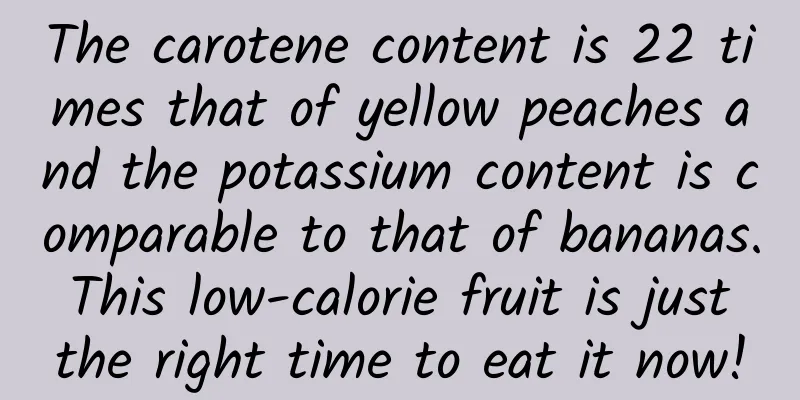The carotene content is 22 times that of yellow peaches and the potassium content is comparable to that of bananas. This low-calorie fruit is just the right time to eat it now!

|
"The green courtyard grows in early summer, plums are plump and apricots are yellow." Now is the season when apricots are ripe. Apricots may sound ordinary, but for many people, they are an irreplaceable delicacy from childhood. Besides being delicious, what nutritional value does apricot have? How can you choose apricots that are sweet, juicy and soft? Copyright images in the gallery. Reprinting and using them may lead to copyright disputes. The delicious taste of apricots Always evolving I wonder if you have noticed that when you were a child, the taste of apricots was a bit like opening a blind box, sometimes sweet, sometimes very sour. But nowadays, most apricots taste sweet. This is actually because apricots have been "evolving", which brings us a better taste experience. Apricots are a native fruit of my country. They have a long history of cultivation in my country. As early as in the Classic of Mountains and Seas, there were records about apricots. As an important economic crop, apricots can be eaten directly as fresh fruits or made into dried apricots. Therefore, from ancient times to the present, people have been working hard on the road of domesticating and improving apricots, and the delicious evolution of apricots has also been happening. 1 More delicious apricot varieties discovered I remember that the apricots I ate when I was a child were mainly yellow in color, and were called "yellow apricots". Yellow apricots are widely grown in northern my country, among which the more famous ones are the camel yellow apricots produced in Beijing and Hebei, the Yangshao yellow apricots produced in Yangshao, Henan, and the Cao apricots produced in Ning County, Gansu. Although these yellow apricots are large in size and have thick flesh, their taste is mainly sweet and sour and fragrant. For those who prefer sweet taste, yellow apricots may not be considered "sweet apricots". In recent years, the "white apricots" with a lighter yellow skin, close to green-yellow or creamy yellow, have gradually been discovered by foodies and are becoming more and more popular. Whether it is the small white apricots produced in Luntai, Xinjiang, the Li Guang apricots from Dunhuang, Gansu, or the fragrant white apricots from Hebei, they all have the characteristics of smooth skin, less hair, rich juice, sweet taste, and tender flesh. 2 More delicious apricots are cultivated and promoted In order to meet people's demand for richer tastes, researchers in the agricultural field have been committed to cultivating and promoting better apricot varieties. The Dutch Fragrant Honey Apricot, which has been gradually promoted from Yantai, Shandong to the whole country in recent years, is a typical example. It is said that it is an apricot variety introduced from the Netherlands in the last century. It is characterized by crispy flesh and extremely high sweetness. The sweetness can reach 17% after maturity. You should know that the sweet watermelons such as Black Beauty and Sweet King are only 12%~13% sweet. Copyright images in the gallery. Reprinting and using them may lead to copyright disputes. Apricots are not only delicious The nutritional value is also excellent Delicious apricots are not just a fruit that looks good and tastes good but is not very useful. They have quite good nutritional value. For example, the most common yellow apricot has a high carotene content. 1 carotene We all know that orange-yellow fruits and vegetables are rich in carotene. Carotene can be metabolized into vitamin A in the body, which can protect eyesight and improve eye discomfort. When vitamin A is deficient, the cornea cannot get enough nourishment to keep it moist, and it is easy to develop dry eyes. When vitamin A is severely deficient, some pigments on the retina that maintain normal visual function cannot be synthesized, resulting in night blindness. The carotene content of yellow apricot is 450 micrograms/100 grams , which is an excellent content among fruits. It is almost 22.5 times that of yellow peach (20 micrograms/100 grams), 9 times that of apple (50 micrograms/100 grams), and 2.8 times that of orange (160 micrograms/100 grams). 2 Lutein and Zeaxanthin Lutein and zeaxanthin are essential nutrients for maintaining the health of the retinal macular area. The lutein and zeaxanthin content in yellow apricot can reach about 89 micrograms/100 grams, which is relatively high among fruits. For example, compared with Hami melon (27 micrograms/100 grams), it is more than three times that. One thing to note is that most of the β-carotene, lutein and zeaxanthin in apricots are concentrated in the peel , and the content in the pulp is relatively lower. When eating apricots, if you can eat them together with the peel, you can get more nutrition. 3 Potassium Apricots are also rich in potassium, reaching 226 mg/100 g, which is nearly 1 times higher than carrots (119 mg/100 g) and close to the potassium content of bananas, which are often recommended as potassium supplements (256 mg/100 g). Copyright images in the gallery. Reprinting and using them may lead to copyright disputes. Who says apricots are “not as good” as peaches? There is an old saying in my country: Peaches make you full, but apricots hurt you. Many old people and elders still agree with this saying. But in fact, apricots and peaches are equally good in every aspect. First of all, in terms of taste, each has its own merits. Although ripe peaches can be divided into soft peaches and crisp peaches, most of them taste sweet and juicy. But apricots are not inferior. Nowadays, there are many varieties of apricots on the market that are as sweet as honey, juicy and delicious. Which one is better or worse, we can only say that each has its own merits. Secondly, in terms of nutritional value, apricots win. In comparison, the calories of peaches and apricots are almost the same, both below 50 kcal/100 grams, and are considered low-calorie fruits. The sugar content of the two is also similar. Apricots contain more dietary fiber than peaches (1.3 g/100 g vs 0.6 g/100 g), more calcium (14 mg/100 g vs 4 mg/100 g), and more beta-carotene, lutein, and zeaxanthin (the content of the above nutrients in peaches is negligible). Therefore, it can be said that the nutritional value of apricots is higher than that of peaches. Why is there a saying that "peaches make you full but apricots hurt you"? This is mainly related to amygdalin in bitter almonds that can cause poisoning. After entering the body, amygdalin decomposes to produce toxic hydrocyanic acid, which is highly toxic and can cause suffocation and death if ingested in excess. However, eating fresh apricots in moderation will not cause this problem. If you want to eat almonds, it is safe to buy ready-made products at regular supermarkets. How to choose apricots? Finally, here are some tips for choosing apricots. 1 Select Origin The Xinjiang small white apricots, Xinjiang small red apricots, Shandong Holland fragrant honey apricots, Laoshan honey apricots, Gansu Li Guang apricots, etc. introduced in the previous article are all well-known delicious apricots. 2 Choose fresh It is better to eat a fresh peach than a basket of rotten apricots. The freshness of the fruit directly determines the taste. Apricots with smooth skin, covered with apricot hairs, plump and round, and green stalks are fresher. 3 Smell the aroma If the apricots smell rich in apricot aroma and have a hint of sweetness, this is a sign of high maturity and sufficient sweetness, and can be used as a criterion when selecting. Nowadays, we no longer need to worry about "apricots falling from the forest into golden plates, and our teeth are too soft to be afraid of the sour taste". As long as we know how to pick, delicious apricots will be waiting for us. This summer, let us taste the sweetness of apricots together! References [1]Weiquan Zhou, Yingying Niu, Xiang Ding, Shirong Zhao, Yalan Li, Guoquan Fan, Shikui Zhang, Kang Liao, Analysis of carotenoid content and diversity in apricots (Prunus armeniaca L.) grown in China, Food Chemistry, Volume 330, 2020, 127223, ISSN 0308-8146. [2] Liu Zhenghao, Pang Yanping, Yang Liping. HPLC analysis of β-carotene in Julu apricot and comparison of its content in apricot fruits from multiple regions[J]. Modern Food, 2021(14):217-222. [3] Du Binhua, Reheman Aila, Chen Qi, Xie Rui, Huang Yadong, Huang Wenshu. Composition and content analysis of main carotenoids in Kumaiti apricot[J]. Food Science, 2019, 40(18): 189-194. Planning and production Author: Wang Lu, registered dietitian in China Review|Zhang Yu, researcher/PhD, Chinese Center for Disease Control and Prevention, national health science expert Planning|Zhong Yanping Editor: Zhong Yanping Proofread by Xu Lailinlin |
>>: The little-known "Four Great Aviation Inventions" of Ancient China
Recommend
Babao Compound Interest Academy·Newbie Wealth Training Camp Course
Course Format: WeChat community interactive mode,...
Service is an important component in Android development
Service Component 「Service」 is a component in And...
Insights: The harder it is, the more you should applaud yourself
Famous Artists Gallery | Lu Yifei, a native of Ch...
Case analysis: How to use WeChat fission to attract traffic to offline stores?
Offline "shopping malls" generally enco...
How to build your own traffic circulation system?
Before I start sharing how to build a traffic cir...
Swift TIP: objc and dynamic
Although the original intention of Swift language...
After upgrading to 4G, which mobile phone has the fastest internet speed?
Of course not Xiaomi phones. Although Lei Jun’s s...
Analysis of hot-selling cases in Internet operations
The past 2021 was a bit magical, a bit miraculous...
The Economist: The age of drones has arrived
The Economist website reported that the scale and...
How to understand a famous book?
Mixed Knowledge Specially designed to cure confus...
How to set prices to achieve the highest profit for products? 5 Win-Win Price Discrimination
In the face of price, all kinds of promotions pal...
Baidu releases a car robot with L5 autonomous driving capabilities, which is officially claimed to be safer than human driving
On August 18, Baidu held its 15th "Baidu Wor...
E-commerce detail page conversion skills worth 50,000 yuan (2)
E-commerce detail page conversion skills worth 50...
The first step to longevity: eat a little fatter!
How fat is healthy? ——A well-proportioned body is...
In the future, what kind of product manager will be irreplaceable?
Taobao Product Platform Department Senior Expert ...









